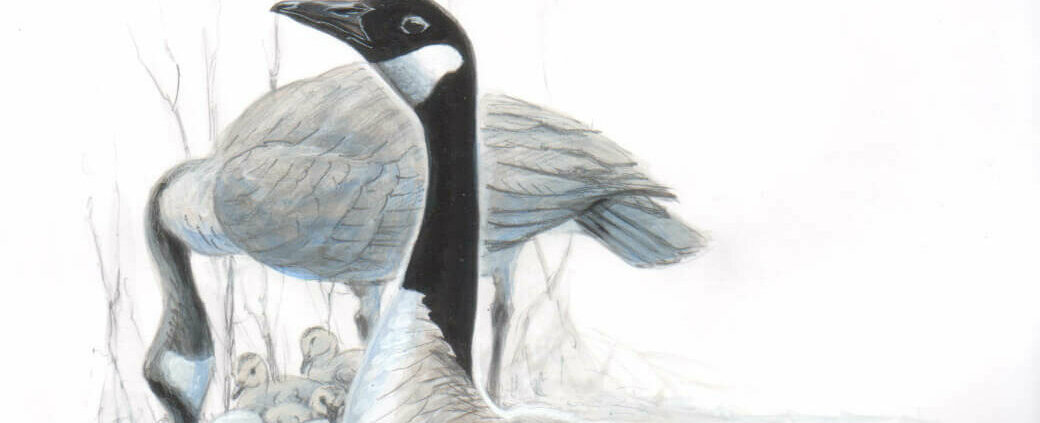The Saga Of Local Canada Geese
Story and image by Doug Pifer
My ears caught the high-pitched calls of wild geese. I spied three V-shaped strings of tiny dots crossing the March sky. Doubting whether the geese would show up in a photo, I snapped a picture with my phone anyway. After enlarging the picture I counted 220 individual geese.
Headed due north, they were following the migration path of their ancestors. I guessed they had spent most of the winter in the vicinity of Chesapeake Bay, or possibly as far south as the coastal Carolinas.
Later in the day a low-flying pair of Canada geese crossed our field toward the creek beside our house, honking loudly. These were locals, very possibly the same pair whose nest I pass on my way to town.
Eighty years ago, it was rare to see a big flock of Canada geese flying northward in the spring. A locally breeding pair of geese was unheard of. Unregulated hunting, plus the destruction of habitat, were the main reasons for their scarceness. Originally most Canada geese ranged across the continent in the winter but migrated north to their breeding grounds in spring. Only one regional subspecies, the giant Canada goose, nested in the continental United States, in the Midwest. Lewis and Clarke first described seeing big geese nesting along the Missouri River in 1804, but by 1900, giant Canada geese were believed to be extinct. Then in 1963 a waterfowl biologist named Dr. Harold Hanson discovered a population of giant Canada Geese around Silver Lake, near Rochester, Minnesota. Much larger than a typical Canada goose, these weighted over 12 pounds. The U.S. Fish and Wildlife Service placed the population under federal protection. State fish and game departments started breeding programs to build up populations of the rediscovered giant Canada geese.
Thus begins one of the most dramatic wildlife success stories in history.
By not migrating, giant Canada geese fare much better in many ways than their relatives by staying in a more moderate climate the year round. By contrast, geese that nest in the high arctic and across northern Canada are highly migratory because their food sources disappear in the harsh winters. And after they return in the spring to their nesting grounds, they have only three months to raise their young. Should the weather be unfavorable, their nesting attempts may fail during that season.
By the 1970s, giant Canada geese had spread across the country with great success. Delighted with the hunting opportunities the “local” geese provided, most states opened special resident goose hunting seasons in September before the migratory Canada geese arrived.
Soon it became clear that hunting hardly made a dent in the goose population, which kept increasing. Local geese made themselves at home on golf courses, private estates, athletic fields, corporate or college campuses, and city parks. The big birds aggressively protected their young, attacking anyone who got too close. They loafed and pooped on public beaches, bike trails, airports, golf greens, sidewalks, and picnic grounds. Pairs of geese, with their young in tow, grazed boldly on swaths of closely mowed grass or sauntered across roads and parking lots, as if they owned the place. Low flying flocks interfered with airline traffic and caused accidents.
Human conflicts and health and safety hazards aside, these circumstances weren’t good for the geese either. When people fed the local geese, the birds lost their fear and became more aggressive. What’s more, as some geese became partial to an unnatural diet of bread, poor nutrition caused their wings to become deformed, inhibiting their ability to fly.
Between the end of June and the end of July, all Canada geese replace their wing feathers and become “grounded” for a few weeks until the wing quills all grow back and harden. Just before this happens, they make a short retreat or “molt migration” to a safe spot where there is plenty of food and they can swim away from ground predators. Because geese are chiefly grazers, they prefer places with easy access to short grass. Riverbeds with flood plains, golf courses, industrial complexes with reservoirs, and parks are favored hangouts at this vulnerable time.
For several years some localities took advantage of this vulnerability, organizing “goose roundups” during the molting period . Designated folks herded the local adult and young geese into enclosures where they were destroyed. This practice was widely condemned and mostly discontinued. Now, more humane alternative control methods prevent geese from nesting or staying in unwanted places. These include using dogs trained to bark and chase, but not to kill, the geese. And, planting tall vegetation, shrubs and trees near ponds or streams where geese gather will keep them away. It creates a situation where geese feel uneasy about being ambushed by predators.
Local Canada goose populations seem to have moderated over the past decade. While I miss watching flocks of geese passing low overhead all year round, I welcome the sight a high-flying V of Canada geese as they migrate to and from their northern nesting grounds each year.










